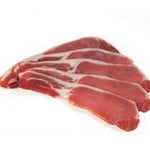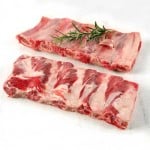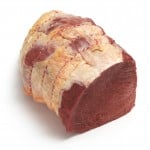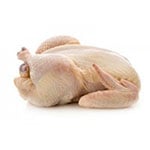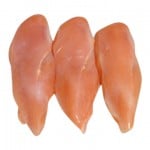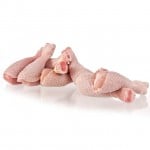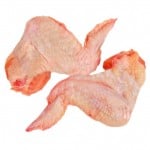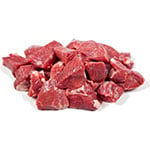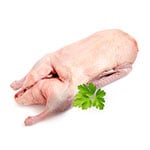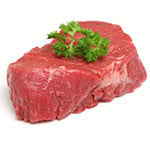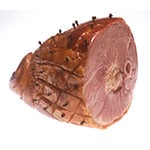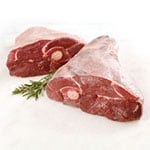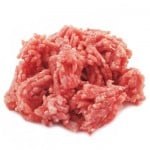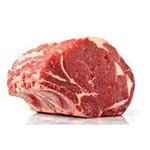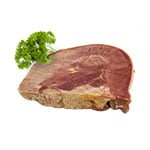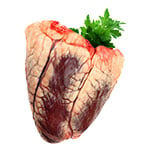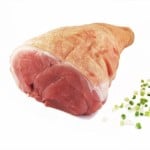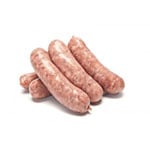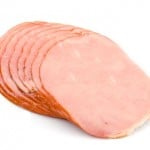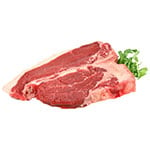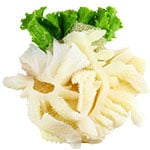Many different animals and birds have been hunted in the wild, but only a few have been raised for their meat. In the ancient civilizations of Egypt, India, China and Greece people raised pigs, sheep, cattle and poultry like chickens and ducks, and all these are still being raised today. Even though much has changed since ancient times, the kinds of meat and poultry we eat today are still mostly the same.

Meat
In a modern supermarket we see the same meats, although the cuts may have changed. Today’s cuts of beef include topside, spare ribs and steaks like fillet and T-bone steak as well as various cuts of veal. We also see legs of lamb and lamb chops as well as mutton from older sheep. Many cuts of pork are also seen, including legs of pork, pork chops and pork spare ribs as well as cured pig meats like bacon and ham. Meats of all kinds are diced for making dishes like stew or minced to make sausages, meat pies and hamburger patties.
Rabbit and goat meat is also eaten in many places, as are various kinds of offal like liver, kidney, heart, tripe and brains. Offal and meats like ox tongue, sheep’s head and pig’s feet or «trotters» are often eaten by people who can’t afford more expensive meats, or in places where every edible part of a slaughtered animal is cooked and eaten. In ancient times people also hunted game like wild boar, deer, quail and pheasant, and all these meats are also eaten today, especially in expensive restaurants.
Poultry
Birds kept as poultry include chickens, ducks, geese and turkeys. Whole birds can be boiled or roasted, or they can be cut into pieces before being cooked. When eating fried chicken, for example, we can eat pieces of breast or wings or drumsticks. Eggs from poultry are also an important type of food, with chicken eggs being the most popular. When shopping, you can choose to buy free-range poultry or free-range eggs if you don’t like factory farming in which birds are kept in small cages and never allowed to range freely in the outside world.
bacon
beef spare ribs
beef topside
chicken
chicken breasts
drumsticks
chicken wings
diced goat meat
duck
fillet steak
ham on the bone or honey glazed ham
leg of lamb
liver
minced pork
mutton
ox tongue
ox heart
pork leg
rabbit
sausages
sliced ham
T-bone steak
tripe
turkey
bacon (noun): meat from the back or sides of a pig that’s cured and sliced — We had bacon and eggs every morning when I was a kid.
beef (noun): meat from a cow, bull or ox — We’re having roast beef and vegetables for dinner.
breast (noun): meat from the front of a bird — Who’d like another piece of chicken breast?
chop (noun): a small cut of meat, usually lamb or pork, from near the ribs — Could you get some pork chops from the supermarket, please?
cure (verb): to preserve meat by smoking, salting or drying — Ham and bacon can be cured by salting or smoking.
cut (noun): a piece of meat cut from a certain part of an animal — That butcher on High Street has the best cuts of beef.
dice (verb): to cut food into small cubes or square-shaped pieces — A steak and kidney pie contains diced meat and gravy.
drumstick (noun): a cooked chicken leg — Don’t eat all the drumsticks!
free-range (adjective): (of poultry) free to live naturally outside instead of being kept inside a farm building — Make sure you get free-range eggs.
game (noun): 1. wild animals and birds hunted by people 2. meat from hunted animals and birds — The only places that serve game these days are expensive restaurants.
ham (noun): cured meat from a pig’s upper leg, usually sliced — I’ll have a ham sandwich, please.
lamb (noun): 1. a young sheep 2. meat from a young sheep — People have been eating lamb for thousands of years.
meat (noun): animal or bird flesh eaten as food — Jason quit eating meat, but he still eats fish and seafood.
mince (verb): to cut meat into tiny pieces, often with a machine called a mincer — If you get some minced beef I’ll make hamburgers for dinner.
mutton (noun): meat from an adult sheep — David thinks they put mutton in the curry instead of lamb.
offal (noun): organs from an animal or bird eaten as food, like liver, heart and kidney — In the past everyone ate offal, but I’ve never tried it.
pork (noun): meat from a pig — Do you know which religions forbid the eating of pork?
poultry (noun): 1. birds kept for their meat or eggs 2. meat from these birds — We serve meat, fish and poultry, all with salad or vegetables.
sausage (noun): minced meat in a long tube of skin, usually fried — How many sausages are you taking to the barbecue?
slaughter (verb): to kill an animal for its meat — Have you ever seen animals being slaughtered in a slaughterhouse?
spare ribs (noun): a cut of pork or beef that contains rib bones — Last night I dreamed about eating spare ribs.
steak (noun): a thick slice of high-quality beef — I don’t think steak and chips is a very healthy dinner for kids.
tripe (noun): the stomach of a sheep or cow eaten as food — My uncle likes tripe, but I think it’s awful.
veal (noun): meat from a calf or young cow — I’ll have the veal with garden vegetables, please.
Contributor: Josef Essberger
Have you ever repeated a word so many times that it seems to lose its meaning? One-syllable words always seem especially funny somehow, and I spent about five minutes this morning daydreaming about meat, of all things. I looked into the history of the word meat, and this led me to wonder about other edible animals, so I researched the words meat, pork, beef and mutton. I found the alternate and historical meanings for these particular words fairly interesting. I thought it was humorous that something as common as the words for simple meats for eating could have ever been known as anything else.
The word meat is quite surprising in its historical and alternate meanings: for example, meat has also been used as a verb. According to the OED, as early as the 11th century, meat has been used in this way to describe the action in which one feeds or provides an animal or person with food or provisions. For example, if you lived on a farm, you might say that you need to meat the cows and goats after breakfast. This comment would have nothing to do with the meat that these livestock would provide, either. The word meat, in this instance refers to solid (versus liquid) sustenance.
The word meat is said to have originated from the Old Frisian word mete; Old Frisian is a Germanic-Dutch language that is still spoken in some places of the world today. In these earliest manifestations of meat, we find various spellings and meanings of the word which all seem to center around a sustenance-substance theme. This early old English was spoken from 450 to 1150, and closely resembled German. Speakers of modern English would not easily recognize this language, as it resembles modern English less than it does modern German. The earliest spellings of the word meat vary widely, as well, in forms such as the Old English spellings of the word: mæte, met, mett, and mete. An example of the Old English usage of the word meat is found in Lindisfarne’s Gospels of Luke, chapter 12, verse 23: “Anima plus est quam esca : se sauel mara is ðon met.” This early version of meat then transformed, metaphorically, from a reference of sustenance or a meal into a more generalized interpretation. An example of this modification is in the Bible’s Book of John, chapter 4, verse 34: “My mete is that I do the will of him that sente me.” This later generalization gave meat the expanded sense of meaning something that is primary sustenance or substance. This expanded definition was so well-received that it was later used in noun and verb form in countless proverbs and phrases, such as “One man’s poison, another man’s meat,” and the ever-popular “meat and potatoes.”
It wasn’t until the 14th century that meat took on a familiar meaning, namely, the edible flesh of animals. This particular specialization of meat is found in Middle English, which was spoken around 1150 to 1450. The Middle English spellings of meat vary widely: maite, mate, meite, metee, meth, meyte, meet, meete, and meett, to name a few. An example of the Middle English usage of the word meat is found in Richard Morris’s version of Lambeth’s Old English homilies: “Ne sculen ȝe nawiht ȝimstones leggen Swinen to mete.” Middle English was followed by what we now consider to be Modern English, which was spoken from 1450 on.
A Modern English version of the word meat is found Norton’s Ordinal of Alchemy in Ashmole Theatrum Chemicum Britannicum, “Without Liquor no Meate is good.” The Modern English version of our language is much more recognizable as the English used today with only slight variances in spelling and usage in historical literature. Later, the word meat also underwent dysphemism by pejoration to also include a definition that describes genitals, prostitution or a corpse. An excerpt from T. Killigrew’s Parsons Wedding, borrows this definition of meat, saying, “Your bed is big enough for two, and my meat will not cost you much.”
It is also interesting to note that the early Old English definition and verb form of meat are still used today in certain regions of England. For example, “A’m jist gaan oot tae mett the hens eenoo” is an excerpt from D. Kynoch’s Lallans, written in 2015.
Interestingly, the word pork, like meat, has been used for centuries as both a noun and a verb. While the word pork is much newer in its usage, its usage history bears a marked resemblance to that of the word meat. Pork, like meat, began as a noun, and its transitive verb form became useful later to describe an act of giving sustenance. Pork made its first appearance near the end of the Middle English period, around 1300. A few spelling variations are based in the Anglo-Norman language, such as porc , pork , porck , porke while other spellings are derived from the Old French and Middle French spelling porc. An excerpt from C. Horstmann’s Early South English Legendary quotes St. Mary Magdalen as saying, “Huy nomen with heom..porc, motoun, and beof.” In this usage, pork refers to a familiar definition: the edible flesh of a pig.
Later, in 1877, pork, like meat, found popularity as a transitive verb springing from the fatty appearance of the pig. F. T. Elworthy provides an example of this humorous euphemism in the Word Somerset Word Book: “I s’pose you’ll pork away thick lot o’ little pigs.” This definition has shifted to describe an action in which something becomes fattened by feeding.
In its latest and most recent incarnations, society has retained these definitions for pork and added to them more specialized and colorful meanings. In the 1960s, pork – like meat in 1664 – came to be known as a sexual term, as in the film American Grafitti, where one character’s declares “They’re porking in the weeds.” This gave rise to humorous euphemisms such as “pork sword,” which is a term for a man’s penis, as well as pejorations such as “pork and beans,” a slang term for the Portugese people that was coined during the First World War.
The word Pork, through a dysphemistic shift that occurred early on in its usage, often carries a derogatory connotation. Pork has also been used as a noun, adjective, and verb to describe a stupid or uncultured person, a fat person, or the act of political pandering.
Like pork, the word beef was first recorded being used in the 12th century in reference to the edible flesh of an animal, only this time it referred to the meat of a cow or other bovine animal. One such use is found in Kyng Alisaunder around 1300: “To mete was greithed beef and motoun.” The word beef was usually preceded or followed by a specific bovine body part to describe the meat, such as rib or sirloin. This noun then generalized to further include other types of food metaphorically, as in R. Lovell’s Πανζωορυκτολογια (Higher Mineralogy) from 1661, saying, “Ling..is counted the beefe of the Sea.” Like meat, beef, also came to be used to refer to the strength or essential substance of something. Beef took on this more generalized definition around 1850, as this excerpt from the Cork Examiner from March 28, 1862 “Chelmsford stood higher in the leg, and showed less beef about him.”
Many spellings of beef are found throughout history. Like pork, beef seems to have its root in Old French. The Old French boef was in turn is derived from the Latin word bov-em, which is distinctly similar to the word bovine of Modern English. Some Middle English spellings of beef include boef, beef, bouf, befe, byffe, beoff, buif, and beff. Plural spellings of beef varied just as widely, including beeves beoffes, buefs, beuys, beues, beves, beafes, beffes, bevis, and beoves.
One interesting shift in the recent specification of the meaning of beef is the use of the word to describe a complaint or grounds for disagreement, which appeared as early as 1900. One such example of this usage is found in the Daily Express from May 22, 1945: “The beef is, why should every battle we fight have to be a ‘Battle of Britain’?”
Like meat and pork, beef was first used as a noun and later gained popularity as a verb. As early as the 19th century, beef was used in this way to describe the act of applying beef directly to a wound or bruise to aid in its healing, as in T. Simmons’s Oakdale Grange : “It will show up in blue and yellow relief..unless they beef it.” Less surprising is the use of beef, like pork, as a verb to describe the act of fattening something up by feeding or the act of slaughtering an animal. Likewise, beef can also be used as a verb to describe the act of complaining, as in S. Lewis’s Babbitt: “Course I wouldn’t beef about it to the fellows at the Roughnecks’ Table there.”
Like beef and pork, the word mutton first made an appearance in the early 12th century. One such example is found in a cookbook dated around 1450, from T. Austin’s Two 15th-cent Cookery Books: “Stwed Mutton: Take faire Mutton that hath ben roste..and mynce it faire.” Also akin to these other meat words, mutton was derived originally from Old French and incorporated into Middle English. Earliest spellings of mutton are highly varied, and include the Anglo Norman-derived moltoun, as well as motene, mowton, mottoune, and muttwn, to name a few. The earliest uses of mutton vary in referring to male goat or sheep, to referring to castrated goats or sheep, and then most recently and widely used to denote the livestock or meat obtained from these animals. A dysphemistic shift in meaning then occurred in the 14th century to use mutton to deprecatingly describe a foolish man, as in R. L. Stevenson’s novel, Wrong Box: “‘You innocent mutton,’ said Michael.” Like meat and pork, mutton has also been used to describe the female genitals as far back as the 16th century, especially in when referring to a prostitute or woman of low character, as in this excerpt from H. Hodge Cab’s Sir?: “He can’t quite believe she hawks her mutton in hexagonal horn-rimmed spectacles.”
The docile nature of the sheep also seems to have inspired other derogatory specification of the word mutton in its usage in the phrase “dead as mutton,” which dates back to 1792. Another phrase uses “hook one’s mutton” to describe the act of dancing with a partner. This docility of the sheep has also inspired the slang adjective form of mutton, which is used to denote someone who is deaf, as in Guardian newspaper from July 23, 1991: “You will have to speak up, I’m a bit mutton.”
In conclusion, it would seem that some societal innovation such as trade must have inspired the necessary specification of all of the different types of meat into categories such as beef, mutton and pork during the 12th century. According to the Oxford English Dictionary, it seems that various semantic shifts in meaning then occurred to denote specific – and often derogatory – versions of each meat-category word. This series of generalizations and specifications, while somewhat twisted, seems logical in that it follows a path of usage that demonstrates change according to the needs and desires of humankind over time. The more colorful specifications of these words seem to resemble the natures of the animals they are named for.
Source referenced:
OED Online. Oxford University Press, December 2015. Web. 21-28 February 2016.
Упражнение 1, с. 39
1. Copy the table in your notebook. Put the words into the correct categories. Add one more word to each category. — Скопируйте таблицу в свою тетрадь. Распределите слова в правильные категории. Добавьте ещё одно слово в каждую категорию.
FRUITS & VEGETABLES: broccoli, banana, cabbage, strawberries (grapes)
ФРУКТЫ И ОВОЩИ: брокколи, банан, капуста, клубника (виноград)
MEAT, POULTRY & FISH: beef, lamb, chicken, salmon (trout)
МЯСО И РЫБА: говядина, баранина, курица, лосось (форель)
DESSERTS: apple pie, chocolate brownie, ice cream, waffles (cherry pie)
Десерты: яблочный пирог, шоколадное пирожное, мороженое, вафли (вишневый пирог)
DRINKS: milk, coffee, cola, tea (orange juice)
НАПИТКИ: молоко, кофе, кола, чай (апельсиновый сок)
Упражнение 2, с. 39
2. Choose the correct words. — Выберите правильные слова.
The drive-through restaurant is one of the USA’s great traditions. It’s unusual because the 1) customers don’t usually go inside! They drive up to a speaker outside the restaurant, 2) order their food from a worker and get it from a window. Customers can go inside and eat at a 3) table, but taking your food to go is more 4) popular. Drive-throughs are very popular in the USA and sell a wide 5) range of 6) fast food, like burgers and fries.
Проездной ресторан — одна из великих традиций США. Это необычно, потому что клиенты обычно не заходят внутрь!Они подъезжают к громкоговорителю возле ресторана, заказывают еду у рабочего и достают её из окна. Клиенты могут зайти внутрь и поесть за столом, но брать еду с собой более популярно. Рестораны на вынос очень популярны в США и продают широкий ассортимент фаст-фуда, таких как гамбургеры и картофель фри.
Упражнение 3, с. 39
3. Choose the odd word out. — Выбери лишнее слово.
1 tub — carton — jar — jam
упаковка — картонная коробка — банка — варенье
2 protein — bones — muscles — skin
белок — кости — мышцы — кожа
3 boil — fry — order — grill
варить — жарить — заказывать — гриль
4 pepper — onion — prawn — celery
перец — лук — креветки — сельдерей
5 salty — fried — sweet — creamy
солёное — жареное — сладкое — сливочное
Collocations
Расположения
Упражнение 4, с. 39
4. Complete with: side, fast, top, jacket, scrambled, cherry, frying, reduce, bunch, cold. — Заполните: сторона, быстрый, верхний, куртка, яичница, вишня, жарка, уменьшение, пучок, холод.
1 cold drinks — прохладдительные напитки
2 top сhef — лучший шеф-повар
3 scrambled eggs — яичница-болтунья
4 side order — дополнительный заказ
5 frying pan — сковорода
6 jacket potato — картофель в мундире
7 fast food — быстрое питание
8 cherry pie — вишнёвый пирог
9 reduce diseases — уменьшить количество заболеваний
10 bunch of bananas — связка бананов
Prepositions
Предлоги
Упражнение 5, с. 39
5. Chose the correct prepositions. — Выберите правильные предлоги.
1 Visitors buy local products made from oranges.
Посетители покупают местные продукты из апельсинов.
2 There’s a great choice of snakes to choose from.
Есть большой выбор змей на выбор.
3 Ann’s is famous for its delicious cherry pie.
Энн славится своим восхитительным вишнёвым пирогом.
4 Chocolate contains a high amout of fat.
Шоколад содержит большое количество жира.
5 Serve the stew with rice.
Подавайте тушёное мясо с рисом.
GAME
In teams, make sentences. Use words/phrases from the list below. Each correct sentences gets one point. The team with the most points wins.
В командах составляйте предложения. Используйте слова/фразы из приведённого ниже списка. Каждое правильное предложение получает одно очко. Побеждает команда, набравшая наибольшее количество очков.
resort — курорт
boiled egg — варёное яйцо
dessert — десерт
poultry — птица
creamy — сливочный
drinks aisle — отдел напитков
frozen food — замороженные продуктыв.
grill — гриль
salty — солёный
tub of ice cream — банка мороженого
loaf of bread — буханка хлеба
protein — белок
deep fried — жарятся во фритюре
baked goods — хлебобулочные изделия
serve — обслуживать
dish — блюдо
scrambled eggs — яичница-болтунья
customers — посетители
menu — меню
chop — нарезать
low-fat — нежирный
spicy — острый
breathe — дышать
Menton is a resort town.
Ментон — курортный город.
Would you like a boiled egg for breakfast?
Хотите варёное яйцо на завтрак?
Apple pie is my favourite dessert.
Яблочный пирог — мой любимый десерт.
Chicken is poultry.
Курица — это птица.
This soup is very creamy.
Этот суп очень сливочный.
You can find cola in the drinks aisle.
Вы можете найти колу в отделе напитков.
Milk and cheese are dairy products.
Молоко и сыр — это молочные продукты.
You can get some ice cream from the frozen food section.
Вы можете купить мороженое в разделе замороженных продуктов.
You grill steaks on a barbecue.
Вы жарите стейки на гриле.
This soup is too salty. There’s a lot of salt in it.
Этот суп слишком солёный. В нём много соли.
Let’s buy a big tub of ice cream.
Давай купим большую банку мороженого.
You can buy a loaf of bread at the bakery.
В пекарне можно купить буханку хлеба.
Meat and fish contain protein.
Мясо и рыба содержат белок.
These chips are deep fried.
Эти чипсы жарятся во фритюре.
Pretzels and bagels are baked goods.
Крендели и рогалики — это хлебобулочные изделия.
Waiters serve customers in a restaurant.
Официанты обслуживают клиентов в ресторане.
My favourite dish is fish ‘n’ chips.
Мое любимое блюдо — рыба с жареной картошкой.
I eat scrambled eggs for breakfast.
На завтрак я ем яичницу-болтунью.
The restaurant has a lot of customers on Sunday nights.
В воскресенье вечером в ресторане много посетителей.
There’s fried chicken on the menu.
В меню есть жареная курица.
Can you chop the onions for me?
Ты можешь нарезать лук для меня?
Is this yoghurt low-fat like chili peppers.
Этот йогурт нежирный, как перец чили.
This chicken is too spicy. I don’t like it.
Эта курица слишком острая.
We couldn’t breathe without our muscles.
Мы не могли дышать без наших мышц.
Quiz
Read through Module 2 and answer the questions. Now write a quiz of your own. Give it to your partner. Check his/her answers.
Викторина
Прочитайте Модуль 2 и ответьте на вопросы. А теперь напишите свой собственный тест. Отдайте его своему партнёру. Проверьте его/её ответы.
1 How many tons of fruit do they use in the Menton Lemon Festival? 145
Сколько тонн фруктов они используют на Ментонском фестивале лимонов? 145
2 In which section can you find yougurt in a supermarket? in the dairy products section
В каком разделе можно найти йогурт в супермаркете? в разделе молочные продукты
3 What is a chippy? a fish ‘n’ chips shop or restaurant
Что такое «чиппи»? рыбный магазин или ресторан с чипсами
4 What can you eat in an ethnic restaurant? dishes from a specific country or culture
Что можно съесть в этническом ресторане? блюда из определённой страны или культуры
5 How much energy doess our brain use? 20% of the energy from the food we eat
Сколько энергии использует наш мозг? 20% энергии из пищи, которую мы едим
6 What can you do at Huntington’s Kitchen? have a free cooking lesson
Что вы можете сделать на кухне Хантингтона? взять бесплатный урок кулинарии
7 What does red meat contain? iron and protein
Что содержит красное мясо? Железо и белок
8 How many bones are there in the human body? over 200
Сколько костей в человеческом теле? более 200
9 What does our skin do? It covers our body, protects us and gives us our sense of touch.
Что делает наша кожа? Она покрывает наше тело, защищает нас и даёт нам чувство осязания.
10 What foods have a lot of calcium in them? dairy products like milk, cheese and yogurt
В каких продуктах содержится много кальция? молочные продукты, такие как молоко, сыр и йогурт
1 What are the most popular ethnic cuisines in the UK? (Indian, Chinese and Italian)
Какие самые популярные национальные кухни в Великобритании? (Индийская, китайская и итальянская)
2 What are baked goods? (cakes and biscuits)
Что такое хлебобулочные изделия? (пирожные и печенье)
3 What has Jamie Oliver’s ‘Food Revolution truck’ got in it? (eight cooking stations and TV plasms screens)
Что у Джейми Оливера в «грузовике пищевой революции»? (восемь кухонных станций и телевизионные плазменные экраны)
4 What do the letters ‘tsp’ stand for? (teaspoon)
Что означают буквы «tsp»? (чайная ложка)
5 What is the healthiest type of chocolate? (Good quality dark chocolate)
Какой самый полезный вид шоколада? (Хороший качественный тёмный шоколад)
6 How many muscles are in the human body? (over 600)
Сколько мышц в человеческом теле? (более 600)
7 When does the Lemon Festival in Menton take place? (every February to March)
Когда проходит фестиваль Лимонов в Ментоне? (каждый февраль-март)
8 What kinds of food are carbohydrates? (cereals, bread and pastа)
Какая пища являются углеводами? (крупы, хлеб и макароны)
9 What do we need to build and repair muscles? (protein)
Что нам нужно для наращивания и восстановления мышц? (белок)
10 In which section can you usually find pears in a supermarket? (the fruit and vegetables section)
В каком разделе обычно можно найти груши в супермаркете? (раздел фруктов и овощей)
← Предыдущее Следующее →
ГДЗ по английскому языку. Starlight. Звёздный английский. Учебник. 6 класс. Баранова К.М., Дули Д., Копылова В.В.
Рабочая тетрадь. Starlight. 6 класс. Workbook.
Английский язык. 6 класс

